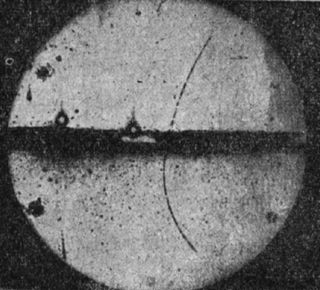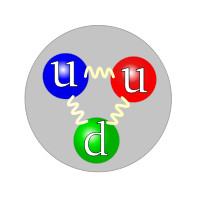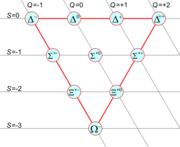List of particles
2007 Schools Wikipedia Selection. Related subjects: General Physics
This is a list of particles in particle physics, including currently known and hypothetical elementary particles, as well as the composite particles that can be built up from them.
- For a chronological listing of subatomic particles by discovery date, see Timeline of particle discoveries.
Elementary particles
An elementary particle is a particle with no measurable internal structure, that is, it is not a composite of other particles. They are the fundamental objects of quantum field theory. Elementary particles can be classified according to their spin, with fermions having half-integer spin and bosons integer spin.
Standard Model
The Standard Model of particle physics is our current understanding of the physics of elementary particles. All Standard Model particles except the Higgs boson have been observed.
Fermions (half-integer spin)
Fermions have half-integer spin; for all known elementary fermions this is ½. Each fermion has its own distinct antiparticle. Fermions are the basic building blocks of all matter. They are classified according to whether they interact via the colour force or not. According to the Standard Model, there are 12 flavours of elementary fermions: six quarks and six leptons.
- Quarks interact via the colour force. Their respective antiparticles are known as antiquarks. Quarks exist in six flavours:
-
Generation Name/Flavor Electric charge ( e) Mass ( MeV) Antiquark 1 Up (u) +2/3 1.5 to 4 antiup quark 
Down (d) −1/3 4 to 8 antidown quark 
2 Strange (s) −1/3 80 to 130 antistrange quark 
Charm (c) +2/3 1,150 to 1,350 anticharm quark 
3 Bottom (b) −1/3 4,100 to 4,400 antibottom quark 
Top (t) +2/3 171,400 ± 2,100 antitop quark 
- Leptons do not interact via the colour force. Their respective antiparticles are known as antileptons (although the antiparticle of the electron is called the positron for historical reasons). Leptons also exist in six flavours:
-
Charged lepton / antiparticle Neutrino / antineutrino Name Symbol Electric charge ( e) Mass ( MeV) Name Symbol Electric charge ( e) Mass ( MeV) Electron / Positron 
−1 / +1 0.511 Electron neutrino / Electron antineutrino 
0 < 0.0000022 Muon 
−1 / +1 105.7 Muon neutrino / Muon antineutrino 
0 < 0.17 Tau lepton 
−1 / +1 1,777 Tau neutrino / Tau antineutrino 
0 < 15.5
Note that the neutrino masses are known to be non-zero because of neutrino oscillation, but their masses are sufficiently light that they have not been measured directly as of 2006.
Bosons (integer spin)
Bosons have whole number spins. The fundamental forces of nature are mediated by gauge bosons, and mass is hypothesized to be created by the Higgs boson. According to the Standard Model the elementary bosons are:
-
Name Charge ( e) Spin Mass ( GeV) Force mediated Photon 0 1 0 Electromagnetism W± ±1 1 80.4 Weak nuclear Z0 0 1 91.2 Weak nuclear Gluon 0 1 0 Strong nuclear Higgs 0 0 >112 See below
The Higgs boson (spin-0) is predicted by electroweak theory, and is the only Standard Model particle not yet observed. In the Higgs mechanism of the Standard Model, the massive Higgs boson is created by spontaneous symmetry breaking of the Higgs field. The intrinsic masses of the elementary particles (particularly the massive W± and Z0 bosons) would be explained by their interactions with this field. Many physicists expect the Higgs to be discovered at the Large Hadron Collider (LHC) particle accelerator now under construction at CERN.
Hypothetical particles
Supersymmetric theories predict the existence of more particles, none of which have been confirmed experimentally as of 2006.
- The neutralino (spin-½) is a superposition of the superpartners of several neutral Standard Model particles. It is a leading candidate for dark matter. The partners of charged bosons are called charginos.
- The photino (spin-½) is the superpartner of the photon.
- The gravitino (spin-3⁄2) is the superpartner of the graviton boson in supergravity theories.
- Sleptons and squarks (spin-0) are the supersymmetric partners of the Standard Model fermions. The stop squark (superpartner of the top quark) is thought to have a low mass and is often the subject of experimental searches.
Other theories predict the existence of additional bosons.
- The graviton (spin-2) has been proposed to mediate gravity in theories of quantum gravity.
- The graviscalar (spin-0) and graviphoton (spin-1).
- The axion (spin-0) is a pseudoscalar particle introduced in Peccei-Quinn theory to solve the strong-CP problem.
- The saxion (spin-0, scalar, R parity=1) and the axino (spin-1/2, R parity = -1) form together with the axion a supermultiplet in supersymmetric extensions of Peccei-Quinn theory.
- The X boson and the Y boson are predicted by GUT theories to be heavier equivalents of the W and Z.
- The magnetic photon.
- Sterile neutrinos are introduced by many extensions to the Standard Model, and may be needed to explain the LSND results.
- Mirror particles are predicted by theories that restore Parity symmetry.
Magnetic monopole is a generic name for particles with non-zero magnetic charge. They are predicted by some GUT theories.
Tachyon is a generic name for hypothetical particles that travel faster than the speed of light and have an imaginary rest mass.
The preon was a suggested substructure for both quarks and leptons, but modern collider experiments have all but disproven their existence.
Composite particles
Hadrons
Hadrons are defined as strongly interacting composite particles. Hadrons are either:
- Fermions, in which case they are called baryons.
- Bosons, in which case they are called mesons.
Quark models, first proposed in 1964 independently by Murray Gell-Mann and George Zweig (who called quarks "aces"), describe the known hadrons as composed of valence quarks and/or antiquarks, tightly bound by the colour force, which is mediated by gluons. A "sea" of virtual quark-antiquark pairs is also present in each hadron.
Baryons (fermions)
Ordinary baryons ( fermions) contain three valence quarks or three valence antiquarks each.
- Nucleons are the fermionic constituents of normal atomic nuclei:
- Hyperons such as the Λ, Σ, Ξ, and Ω particles, which contain one or more strange quarks, are short-lived and heavier than nucleons. Although not normally present in atomic nuclei, they can appear in short-lived hypernuclei.
- A number of charmed and bottom baryons have also been observed.
Some hints at the existence of exotic baryons have been found recently; however, negative results have also been reported. Their existence is uncertain.
- Pentaquarks consist of four valence quarks and one valence antiquark.
Mesons (bosons)
Ordinary mesons ( bosons) contain a valence quark and a valence antiquark, and include the pion, kaon, the J/ψ, and many other types of mesons. In quantum hadrodynamic models, the strong force between nucleons is mediated by mesons.
Exotic mesons may also exist. Positive signatures have been reported for all of these particles at some time, but their existence is still somewhat uncertain.
- Tetraquarks consist of two valence quarks and two valence antiquarks.
- Glueballs are bound states of gluons with no valence quarks.
- Hybrids consist of one or more valence quark-antiquark pairs and one or more real gluons.
Atomic nuclei
Atomic nuclei consist of protons and neutrons. Each type of nucleus contains a specific number of protons and a specific number of neutrons, and is called a nuclide or isotope. Nuclear reactions can change one nuclide into another. See Isotope table (complete) for a list of isotopes.
Atoms
Atoms are the smallest neutral particles into which matter can be divided by chemical reactions. An atom consists of a small, heavy nucleus surrounded by a relatively large, light cloud of electrons. Each type of atom corresponds to a specific chemical element, of which 111 have been officially named. Refer to the periodic table for an overview.
Molecules
Molecules are the smallest particles into which a non-elemental substance can be divided while maintaining the physical properties of the substance. Each type of molecule corresponds to a specific chemical compound. Molecules are composites of one or more atoms. See list of compounds for a list of molecules.
Condensed matter
The field equations of condensed matter physics are remarkably similar to those of high energy particle physics. As a result, much of the theory of particle physics applies to condensed matter physics as well; in particular, there are a selection of field excitations, called quasi-particles, that can be created and explored. These include:
- Phonons are vibrational modes in a crystal lattice.
- Excitons are bound states of an electron and a hole.
- Plasmons are coherent excitations of a plasma.
- Polaritons are mixtures of photons with other quasi-particles.
- Polarons are moving, charged (quasi-) particles that are surrounded by ions in a material.
- Magnons are coherent excitations of electron spins in a material.
Other
- A WIMP (weakly interacting massive particle) is any one of a number of particles that might explain dark matter (such as the neutralino or the axion).
- The pomeron, used to explain the elastic scattering of hadrons and the location of Regge poles in Regge theory.
- The skyrmion, a topological soliton of the pion field, used to model the low-energy properties of the nucleon, such as the axial vector current coupling and the mass.
- A goldstone boson is a massless excitation of a field that has been spontaneously broken. The pions are quasi-Goldstone bosons (quasi- because they are not exactly massless) of the broken chiral isospin symmetry of quantum chromodynamics.
- A goldstino is a Goldstone fermion produced by the spontaneous breaking of supersymmetry.
- An instanton is a field configuration which is a local minimum of the Euclidean action. Instantons are used in nonperturbative calculations of tunneling rates.
- A dyon is a hypothetical particle with both electric and magnetic charges
- A geon is an electromagnetic or gravitational wave which is held together in a confined region by the gravitational attraction of its own field energy.
- An Oh-My-God particle is an ultra-high energy cosmic ray (probably a proton) falling well beyond the GZK cutoff, the energy limit beyond which virtually no cosmic rays should be detected.
- A spurion is the name given to a "particle" inserted mathematically into an isospin-violating decay in order to analyze it as though it conserved isospin.
Classification by speed
- A tardyon or bradyon travels slower than light and has a non-zero rest mass.
- A luxon travels at the speed of light and has no rest mass.
- A tachyon (mentioned above) is a hypothetical particle that travels faster than the speed of light and has an imaginary rest mass.



